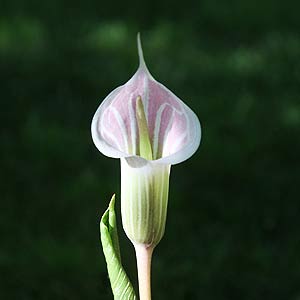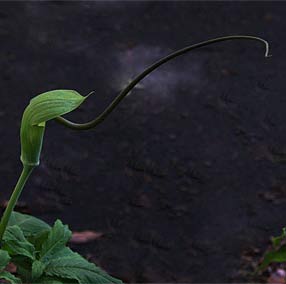
Cobra Lily or Jack in the Pulpit.
Arisaema are a woodland plant and as such prefer a cool semi-shaded position and moderately rich soil, species include the attractive Arisaema candidissimum (picture right lower) with scented flowers and great foliage which lasts through summer and Arisaema sikokianum with its glowing white spadix hooded and fascinating. Much sought after is the lovely A. griffithii a little rare in Australia at present.
These bulbs are also referred to as ‘Cobra lilies’ and ‘Jack in the Pulpit’, but with so many species the botanical names are best used.
As with Arisaema ringens, variety also exists with species including flower colour and foliage colour.
Arisaema Growing tips and Cultural Notes
Fertilizing, watering and dividing & general comments : Arisaema may be left undisturbed for several years, mulch lightly with a good well rotted compost late in winter.
Refrain from watering these bulbs during winter, but water well once a week spring through summer. To help growth top dress in late winter with a complete fertilizer.
Plant 4-5 cm deep, 10cm between bulbs. They do require a well drained soil and some species will tend to self seed, so remove seed heads as they form if this is an issue. Seeds are generally heavy so they tend not to blow around the garden.

More Bulb Resources
Arisaema bulbs and plants are available for sale form the following nurseries
412 James Lane, Fern Hill VIC. 3458 - Phone 0419002651
Large range of Rare plants, Climbers, Bulbs, Perennials Fruit Trees, Ornamental Trees and Shrubs. Available both Retail and by Mail Order
www.whitehousenursery.com.au
Large variety of Epimediums, Woodland plants and Herbaceous perennials
Mail order or nursery. We do not send to Tasmania or WA
www.cloverhillrareplants.com
'Sylvan Vale' 375 Olinda Creek Rd, Kalorama, VIC.3766
Including a large range of Rare and unusual bulbs, corms and perennials
www.tonkinsbulbs.com.au
125 Palmer Rd Jindivick 3818
Open Thursday - Sunday 10am - 4pm
Specialising in growing and selling Rare and Unusual Trees, shrubs Perennials Bulbs and Climbers, a unique nursery with amazing stock.
www.muskersbroughtonhall.com.au
PO Box 7040 Leura NSW 2780
Rare woodland plants, Trilliums Epimediums, Arisaemas, plus much more.www.lynnsrareplants.com.au





